Vol 4 No. 35 TROPIC LIGHTNING NEWS September 1, 1969
Index
| Unit Page | Unit Page | Unit Page | Unit Page |
| 1/27 6 | 2/14 Photo 3 | 3/22 6 | 4/23 Photos 7 |
| 1/27 Photo 6 | 2/14 Photo Spread 4 | 3/22 8 | 4/23 Photo 8 |
| 2d Bde 3 | 2/14 8 | 4/9 1 | 65th Engr 6 |
| 2d Bde S-1 Photo 6 | 2/22 1 | 4/9 8 | 65th Engr 8 |
| 2/12 2 | 2/27 3 | 4/23 1 | 65th Engr Photo 8 |
| 2/12 8 | 2/27 Photo 3 | 4/23 Photo 1 | 7/11 1 |
| 2/14 3 | 3/4 Cav 1 | 4/23 7 | Red Cross Photo 3 |
It's A Bad Trip for NVA-Flare Warns
Tomahawks of Attack
By SGT Roger Welt
TAY NINH
- Forty-one North Vietnamese soldiers died August 21, during a premature
pre-dawn attack on the night defensive position of Bravo Company,
4th Battalion (Mechanized), 23rd Infantry, at the base of Nui Ba Den.
The Americans took no
casualties.
SHORTLY
BEFORE 2:00a.m., the Tomahawks spotted movement to the northwest of
their position as the enemy attempted to evade the allied screening operation.
First a trip flare burst
less than 100 meters away as one heavy footed NVA soldier tried to hot-foot it
out of the place. Then, as the
enemy squad realized that they'd given themselves away, a hail of RPGs and
mortars hit the allied position.
"As soon as we spotted the
movement the enemy opened up," said PFC Gary Hodgson of San Pedro, California.
"My armored personnel carrier was hit by an RPG round and the next
thing I remember I was picking myself up off the ground.
I immediately jumped back on the track and fired into the enemy
position."
Calling on 14 light fire
teams, two spooky gunships and an air strike, the Tomahawks poured fire on the
NVA. Artillery support from 7th
Battalion, 11th Artillery guns took up the fire, sending the 105min shells
pounding in on the enemy.
"THE MEN
WERE calm and in complete control throughout the night.
We've hurt the enemy badly in this area and we'll continue to do so
if they keep thinking they can walk through us," said Major David Kiger of
Arlington, Va., the Tomahawk operations chief.
As the enemy reeled back
from the contact area seeking to find a safer position, they walked into the
final lesson: a Tomahawk ambush team. Opening
up on the escaping NVA, Bravo Company soldiers called in more gunships to help
block the enemy retreat.
There was no safe exit.
An early morning sweep into
the area caught three suspects and captured four AK-47 assault rifles, four RPG
launchers, 15 RPG rounds, 14 Chicom grenades, and assorted web gear abandoned by
the beaten enemy force.
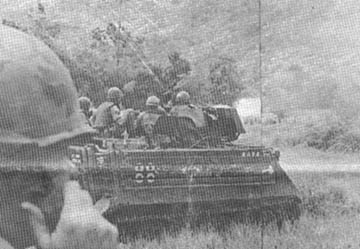 |
POURING IT ON - A track-mounted mini-gun of the 4th Battalion (Mechanized), 23d Infantry Tomahawks saturates suspected enemy positions at the base of Nui Ba Den while a Tomahawk officer calls in additional firepower (foreground). (PHOTO BY PFC SAM DIXON) |
2/22 Too, Too Much To
22 NVA
By PFC Dennis Bries
TAY NINH
- Information supplied by an enemy suspect helped the men of the 2d Battalion
(Mechanized), 22d Infantry, overtake a fortified North Vietnamese tunnel and
bunker complex in the Boi Loi
Woods.
Twenty-two enemy died in the
day-long battle in which gunships and air strikes aided the ground troops.
While
Alpha and Bravo Companies of Triple Deuce were conducting a ground
reconnaissance in the Boi Loi Woods, they spotted fresh foot prints and trails
which led them to the fortified enemy bunker complex.
Initial contact with the NVA
in one tunnel resulted in one NVA killed and a suspect detained.
Information from the detainee indicated that approximately 30 enemy were
in the area. The unit, he said, had
orders to stay and fight from their fortified bunkers located in the weeds and
grass which concealed their positions.
Before heavier firepower
could be brought in, men from the first and second platoons of Alpha Company
used hand grenades in an effort to silence the enemy positions. According to
Second Lieutenant John Q. McShane of University City, Mo., a platoon leader, the
men were using fire and maneuver to engage the enemy as close as five to ten
meters from their bunkers.
Using this information,
Lieutenant Colonel Bruce F. Williams, battalion commander, of Vienna, Va.,
coordinated artillery from Dau Tieng base camp and Fire Support Bases Hampton
and Wood III, along with gunships and air strikes.
The enemy positions were quickly destroyed.
Williams added, "The
operations were highlighted by the coordination of artillery and air power,
which insured continuous fire upon the enemy in the area, and by the bravery and
determination of Alpha and Bravo Companies on the ground."
Manchus
Repel Sappers
By
PFC Richard Sears
TAY
NINH
- Driving off a fierce, pre-dawn sapper attack on their position, men of Alpha
Company, 4th Battalion, 9th Infantry, killed 21 North Vietnamese soldiers.
The battle took place 10
mites northeast of Tay Ninh City at Fire Support Base Saint Barbara, the
"French Fort."
Action started shortly after
3:00 a.m. during a heavy morning rain. The
sound of rocket-propelled grenades and incoming mortars broke through the drone
of the downpour. Taking cover in
bunkers, the 4/9 Manchus kept a careful vigil on the tall, thick grass in front
of the bunker line.
Soon after the initial
barrage, NVA sappers burst out of the grass and stormed the berm, tossing
grenades and satchel charges as they charged.
Most of the enemy grenades and satchel charges were thrown back at the
sappers.
The enemy tried to come over
the high northeast wall of the fire support base, built on the site of a French
fort during the colonial era. None
of them got any further than the top of the wall before being blown off by the
accurate firepower of the Manchus.
"The enemy got on the top
of the bunker line but that was as far as he got.
I saw one on top of my bunker and immediately shot him, throwing him back
outside the perimeter," commented platoon leader First Lieutenant Shane M.
Davis of Kansas City, Mo.
At break of dawn the battle
was over. Twenty-one North
Vietnamese, all members of sapper teams, lay dead around the perimeter.
"The men fought hard.
These sapper teams are well trained and tough," said Alpha Company
commander, Captain Freddie Capps Jr., of Tucson, Ariz.
When a sweep was conducted,
the Manchus found two AK47 assault rifles, two RPG launchers and six RPG rounds.
They also picked up five satchel charges that never got to their intended
targets.
| And
Along Came Jones CU CHI - They had her tied to a tree (They had me tied to a tree!), and they had threatened to kill her (They said they'd kill me!), because she had aided the Regional Forces effort in the area (I helped out the RF-PFs!), and they were just about to shout fire (They were going to holler Fire, Fire!), and then along came Jones. Specialist 4 Edward Jones of Waterfall, N.Y., and the rest of Bravo Troop, 3d Squadron, 4th Cavalry, came along to the rescue of a 35 year old Vietnamese woman, nine miles north of Cu Chi. She had been indeed tied to a tree and was apparently about to be executed by the Viet Cong for aiding the allied effort when the men of McKenzies Raiders moved in on a routine sweep to rescue the damsel in distress. Jones was far from slow walking, though, as the Sheridan tanks he and the other Raiders rode crashed through the underbrush. "Well, I really didn't have much to do with it," said Jones. "We spotted her and thought at first that it was a trap, but it wasn't and of course we cut the ropes - I mean she was really tied to a tree." The bruised but safe lady was returned to her hamlet nearby after she had explained her Perils of Pauline predicament. |
|
Page 2 TROPIC LIGHTNING NEWS September 1, 1969
Decorated
| SILVER STAR |
|
| LTC
George E. Taylor, HHC, 4th Bn, 23d Inf MAJ Ronald L. Baker, HHC, 1st Bn, 5th Inf CPT William A. Vestal, Co C. 3d Bn, 22d Inf 1LT Carl M. Zuzulock, HHC, 1st Bde SFC Harry M. Meyer, HHC, 1st Bde SSG Lloyd Lee, Co B, 1st Bn, 5th Inf |
SP5
Alex Johnson, HHT, 3d Sqdn, 4th Cav PFC Johnny Gibson, Co A, 2d Bn, 12th Inf PFC James P. Byrd, Co A, 2d Bn, 12th Inf PFC Gary L. White, Co A, 2d Bn, 12th Inf PFC Paul E. Fabrisi, Co B, 1st Bn, 5th Inf |
BRONZE STAR FOR HEROISM |
|
| 1LT
John R. Work, A Trp, 3d Sqdn, 4th Cav SSG Herman R. Allen, Co B, 1st Bn, 5th Inf SP4 Thomas E. Hughes, HHC, 1st Bde SP4 Ben J. Von Allmen, A Btry, 7th Bn, 11th Arty SP4 James M. McDermitt, HHS Btry, 7th Bn, 11th Arty PFC Larry L. Niemeier, Co A, 3d Bn, 22d Inf PFC Theodore H. Kloster, Co A, 3d Bn, 22d Inf FC Robert F. Hall, Co C, 4th Bn, 23d Inf PFC Charlie G. Keeton, Co C, 4th Bn, 9th Inf PFC Arthur R. Davis, Co B, 4th Bn, 23d Inf PFC Jerry Lewis, Co C, 4th Bn, 23d Inf PFC Timothy E. Silcox, Co B, 4th Bn, 9th Inf PFC William E Doll, Co C, 3d Bn, 22d Inf PFC Albert H. Kirby, Co C, 4th Bn, 23d Inf PFC Bradley H. Cousino, Co A, 4th Bn, 23d Inf PFC David Huffman, Co B, 4th Bn, 23d Inf PFC Robert Gottshall, B Trp, 3d Sqdn, 4th Cav PFC Donald Ackley, 46th Inf Plt PFC Phillip W. Duer, Co D, 2d 14th Inf PFC George Kelly Jr., Co C, 1st Bn, 27th Inf PFC Walter Koehler, Co E, 2d Bn, 12th Inf PFC Marvin L.Lindsay, Co C, 2d Bn, 27th Inf PFC Harold L. Hubka, B Trp, 3d Sqdn, 4th Cav PFC Michael Themmen, Co B, 4th Bn, 9th Inf PFC Paul T. Johnson, B Btry, 1st Bn, 8th Arty PFC Fred M. Howard, A Btry, 2d Bn, 77th Arty PFC Robert Richins, Co B, 4th Bn, 9th Inf PFC Thomas J. Fields, HHC, 1st Bn, 5th Inf PFC Alvin Fondren, Co E 2d Bn, 12th Inf PFC Walter Koehler, Co E, 2d Bn 12th Inf PFC Brian P. Russell, Co D; 1st Bn, 27th Inf PFC Delmar P. L'Hoste, B Trp, 3d Sqdn, 4th Cav |
PFC
Robert O. Bruening, Co D, 1st Bn, 27th Inf PFC Jack A. La Chance, Co C, 4th Bn, 23d Inf PFC Richard A. Karow, Co C, 4th Bn, 23d Inf PFC Jimmy E. Parker, Co C, 4th Bn, 23d Inf PFC Frederick L. DeBolt, B Btry, 1st Bn, 8th Arty PFC Eugene D. Butcher, B Btry, 1st Bn, 8th Arty PFC Chris Clay, Co C, 4th Bn, 23d Inf PFC Herbert M. Dailey, B Btry, 1st Bn, 8th Arty PFC Daniel E. Workman, Co A, 2d Bn, 34th Armor PFC Raymond C. Landa, Co C, 4th Bn, 23d Inf PFC Julio Quinones Jr., Co A, 4th Bn, 23d Inf PFC Gary J. Plummer, B Btry, 1st Bn, 8th Arty PFC Eddie R. Hicks, B Btry, 1st Bn, 8th Arty PFC John W. Larson, B Btry, 1st Bn, 8th Arty PFC Richard A. Gillin, 1st Bn, 8th Arty PFC Kenneth Caron, B Btry, 1st Bn, 8th Arty PFC Kent U. Bjornstad, B Btry, 1st Bn, 8th Arty PFC John C. Massey, Co C, 1st Bn, 27th Inf PFC Ronald Woodall, Co C, 1st Bn, 27th Inf PFC Stephen Knowlton, Co B, 4th Bn, 9th Inf PFC William Kennedy, Co B, 4th Bn, 23d Inf PFC David W. Lowe, Co B, 4th Bn, 23d Inf PFC William Garcia, HHC, 4th Bn, 23d Inf PFC Thomas Egger, HHC, 4th Bn, 23d Inf PFC William R. Henry, D Trp, 3d Sqdn, 4th Cav PFC William E. Muehlheim, D Trp, 3d Sqdn, 4th Cav PFC Tommy L. Story, D Trp, 3d Sqdn, 4th Cav PFC Ronald D. Williams, B Trp, 3d Sqdn, 4th Cav PFC Leroy McPhatter, B Btry, 1st Bn, 8th Arty PFC Richard E. Emberland, B Trp, 3d Sqdn, 4th Cav PFC Harold G. Warp, B Btry, 1st Bn, 8th Arty |
Tropic Lightning Tots
The Commanding General Welcomes
The Following Tropic Lightning Tots
To The 25th Infantry Division – As
Reported By The American Red Cross.
Born To:
| Aug.
10 PFC Ray Strickland, 554th Eng Bn, a girl Aug. 11 SP4 Balentin Pacheco, HHC, 2d Bn, 34th Armor, a girl, Aug. 14 SP4 James Brown, HHB, lst Bn., 8th Arty, a boy SP4 Urben Castellano, 159th Med Bn, a girl, Aug. Aug. 15 SP5 Arthur Vantine, 25th Avn Bn, a boy, Aug. 15 Aug. 16 SP4 Glen Moran, 36th Sig, a girl |
Aug.
16 PFC Jan Feehan, HHC, 725th Maint Bn, a girl Aug. 17 SP4 Harold Green, 554th Eng Bn, a girl Aug. 20 PFC David Gunderson, 116th Asst Hel Co, a girl SP5 Ronald Monk, HHC, 2nd Bn, 27th Inf, a boy PFC Thomas Frederick, 25th MP Co, a boy SGT Henry Seemore, 25th Avn Bn, a girl Aug. 21 SGT Thomas Borders, 1st Bn, 5th Inf, a girl SGT Ralph Gossen, HHC, 25th Med Bn, a boy |
The TROPIC LIGHTNING NEWS is an authorized publication of the 25th Infantry Division. It is published weekly for all division units in the Republic of Vietnam by the Information Office, 25th Infantry Division, APO San Francisco 96225. Army News Features, Army Photo Features, Armed Forces Press Service and Armed Forces News Bureau material are used. Views and opinions expressed are not necessarily those of the Department of the Army. Printed in Tokyo, Japan, by Pacific Stars and Stripes.
MG Ellis W. Williamson . . . . Commanding General
MAJ John C. Fairbank . . . . . Information Officer
1LT John C. Burns . . . . . . . . Officer-in-Charge
SP5 Charles Witrow. . . . . . . Editor
SP5 Ralph Novak . . . . . . . . . Assistant Editor
SP4 David DeMauro. . . . . . . Production Supervisor
BATTALION CORRESPONDENTS
| SGT Jon Anderson SP4 Dennis Dibb PFC John Frame PFC Sam Dixon SP4 K.C. Cullen SP4 Arthur Brown PFC Larry Goodson SP4 Pete Freeman |
1/5 1/5 4/23 4/23 3/22 2/12 2/12 7/11 |
PFC Richard Sears SP4 Carl Detrick PFC Frankie Ditto PFC Victor Allison PFC Phil Jackson PFC Craig Sampson SP4 Pat Morrison |
4/9 2/34 2/14 3/4 2/27 2/27 3/13 |
Tropic
Lightning
Combat Honor Roll
Sergeant Rollace J. Williams
of Company A, 2d Battalion, 12th Infantry Warriors, has been added to the Tropic
Lightning Combat Honor Roll.
Williams' unit was on a
reconnaissance mission when it suddenly was hit by a heavy volume of hostile
fire from a well-concealed enemy bunker position.
During the initial contact,
a member of the Warriors' lead element was seriously wounded and fell in an
exposed position directly in front of the enemy emplacement.
Although subjected to a
barrage of fire directed almost completely at him, Williams moved through the
enemy's kill zone to a position near the bunker and began placing suppressive
fire on the insurgents as he directed
his squad in an assault against the stronghold.
Then, despite the continuing
enemy fire, Williams moved to a position from which to fire his M-72 light
antitank weapon (LAW) at the bunker.
He scored a direct hit,
giving his unit time to evacuate the wounded man and move on into a thorough
search of the area.
Rules
Require Detainee Care
How should a detainee be
treated when he is apprehended?
As long as a suspect is in
your custody he is a detainee and is subject to treatment set forth in the
Geneva convention and MACV system for the evacuation and processing of persons
detained in combat.
They must be provided with
adequate shelter, food, clothing and medical attention until the time they are
classified by Vietnamese officials.
Detainees are classified
into one of four categories: innocent
civilians, prisoners of war, returnees, or civil defendants. Innocent civilians are released and returned to their home.
Prisoners of war are evacuated to an ARVN prisoner of war camp.
Returnees are turned over to the Vietnam government where they are
reindoctrinated under the Chieu Hoi program.
Civil defendants are released to the appropriate government authorities.
Remember, maltreatment of
detainees could cause loss of valuable information and intelligence that could
save lives and be helpful on future operations.
The status of detainees
taken is not a cut-and-dried matter, but the way they are treated is simple, if
you treat them properly it cannot help but work to our advantage.
The most important thing to remember is that quick evacuation and careful
treatment of detainees will help everyone involved with the effort in Vietnam.
| WHAT HAPPENS after you have apprehended detainees who may be Viet Cong but may also be innocent civilians? It's important to be aware of proper procedure in dealing with detainees. | 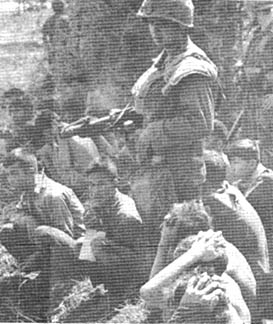 |
A
Quick Quiz On Vietnam's Social Rules
How
well do you know Vietnamese customs?
1. In Vietnam, it is an
obscene gesture to (8) scratch your ear; (b) cross your fingers; (c) sing in
public.
2. To beckon someone, it is
best to (a) call, "Hey, Mama-san, come here" (b) use your index finger; (c)
make the gesture Americans usually think of as waving good-bye.
3. It is bad manners to (a)
smoke in front of a child; (b) hop on your left foot; (c) point the sole of your
boot at someone.
4. You should not (a) put
your hands in your pockets; (b) have long hair; (c) pat anyone on the head.
5. An insult in both America
and Vietnam is (a) calling someone a fink; (b) sticking your tongue out at
someone; (c) singing off-key.
6. You can usually recognize
Buddhist religious leaders by (a) their long beards; (b) their white gloves; (c)
their long robes, usually red or yellow.
Answers: l-b; 2-c; 3-c; 4-c;
5-b; 6-c.
Remember, more Americans
carry rabbits' feet than any other people.
Page 3 TROPIC LIGHTNING NEWS September 1, 1969
Dragon
Stand-Downers Get Homemade R&R
CU
CHI -
A new kind of stand-down that just about amounts to a special R & R has
recently been started by the 2d Battalion 14th Infantry, a unit of the Fire
Brigade.
Each of the five companies
in the battalion sends two men in from the field to Cu Chi every week.
For four days the men relax on their own private stand-down.
THE
IDEA WAS
conceived by Sergeant Major Peter Howlett and put into operation by First
Sergeant Cleo Stevens of the Golden Dragons' Headquarters Company.
Ten men at a time are in Cu
Chi for the stand-down. When the
men arrive in the battalion area, they are required to report to Stevens.
After an hour of required maintenance on field gear the men are shown to
a special hootch and turned loose to do as they please for three days.
The stand-down area is
located away from the activity of the battalion so that the men can have maximum
privacy.
"It's really great!,"
said Specialist 4 Chester Chambers, one of the first men to come in under the
program. "The hootch is clean and
even has a TV." Chambers is a
Bravo Company Golden Dragon from Decatur, III.
THE
TELEVISION
set, along with three free beers and a free soda, are provided the troopers by
the battalion EM Club as soon as they reach Cu Chi.
The men also have magazines,
newspapers and books supplied for them. The
idea is to give the 2nd Brigade soldiers three days of complete relaxation.
They can sleep in, write letters, read - anything they wish.
It's a short break from
the hardship and danger the Golden Dragons face in the rice paddies - but it is
a long-awaited and well-deserved one.
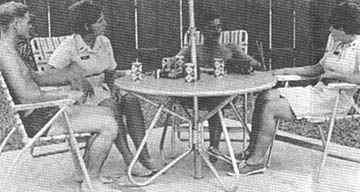 |
| TENNIS, ANYONE? - Two Golden Dragons from the 2d Battalion, 14th Infantry on stand-down enjoy the company of two Red Cross girls during hours of leisure at Cu Chi. Specialist 4 Jeff Wilcox, Los Altos, Calif., (left) and Specialist 4 Chester Chamgers, Decatur, Ill., talk with Donut Dollies Carol Skaff, Houston, Tex., (left) and Teri Dickerson, Watertown, Conn., at the Tropic Lightning swimming pool, Waikiki East. (PHOTO BY PFC FRANK DITTO) |
Recon
Team Uses Navy 'Sniffer,' Finds VC Ammo
By PFC Phil Jackson
CU
CHI -
The reconnaissance platoon of the 2d Battalion 27th Infantry Wolfhounds and its
Vietnamese Province Force counterpart invaded a Viet Cong base camp recently,
gathering more than 100 enemy mortar rounds, along with other ammunition and
equipment from Charlie's stockpile.
The cache was located 12
miles southwest of the division's Cu Chi base camp.
FOUND
IN THE
cache were 47 82mm mortar rounds, 72 60mm mortar rounds, 75 B-40 rocket rounds,
20 booby trap grenades, 20 Chicom hand grenades and 2100 rounds of AK
ammunition. Also picked up by the
combined forces were 72 cans of both regular and variable time mortar fuses, 20
B-40 rocket boosters, one 40-pound giant claymore mine and four sampans.
A Centaur gunship team
working south of the Sugar Mill reported a large bunker complex and indications
of recent activity on the western bank of the Oriental River. The combined reconnaissance team moved out of its home base
at Duc Hue District headquarters to meet the Navy at Ap Hoa.
A blocking force was set up
by the 134th Regional Force Company, while the 604th RF Company and the combined
reconnaissance element moved down the Oriental to their landing point.
The two company-size
elements swept inland along parallel routes searching for the enemy. The reconnaissance team came upon the bunker complex which
appeared to be base camp size, with sleeping positions and a mess area.
Using a metal-sensing device
borrowed from the Navy, the allied force began to probe the area for weapons.
A few of the B-40 rocket rounds along with some of the mortars were found
in the bunkers. Then Sergeant First
Class Theotas Tucker of Muskegon Heights, Mich., and his "magic stick" went
to work.
PLATOON
LEADER
First Lieutenant Philip Dean of Rochester, N.Y., was checking out a canal for
weapons when he called for Tucker. "He
was working his way up to where we were when he picked up readings on his
'metal sniffer,'" said Dean.
"I covered an area about
nine square feet," says Tucker. "That
was the spot where we discovered the major portion of our cache."
"With so much trail
activity in the area, the many bunkers and this ammunition supply, it looks as
if Charlie was preparing for a long stay until we found him," said Specialist
4 Elliott Paige of San Antonio, Tex.
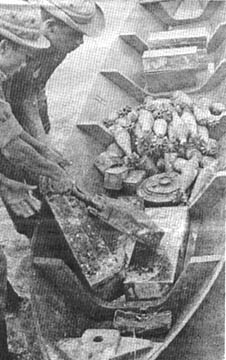 |
FISHY-LOOKING CATCH - Vietnamese soldiers remove some of the material they captured during a combined reconnaissance sweep by Popular Forces troops and the Reconnaissance Platoon of the 2d Battalion, 27th Infantry Wolfhounds 12 miles southwest of Cu Chi. Part of the materiel was found in two sampans floating near the banks of the Oriental River. (PHOTO BY PFC PHIL JACKSON) |
25th
Brews Up Night Kit For New Style Laager
By
1LT J.T. Richards
CU
CHI -
Darkness falls onto an afternoon of heavy fighting as an infantry company
prepares a night defensive position two miles from its support base.
A tired soldier finally
relaxes a moment, licks his dry lips and wishes he hadn't finished off the
last of his water a couple of hours earlier.
Nearby, another infantryman, dirt caked on his sweat-soaked fatigues,
peers out across the rice paddies thinking he is so hungry even "C" rations
would taste good right now.
A
SQUAD LEADER
passes from man to man. In the back
of his mind he's wishing for a few extra claymore mines and trip flares to put
between his men and the enemy.
A short distance away a
platoon sergeant is telling his platoon leader that there's a shortage of
ammunition. The platoon leader checks his watch.
It's getting late. Short
on ammo, more protective cover needed and no place to get them. These are his thoughts as he prepares to get his men into
position for the night.
The company commander
understands the importance of remaining in the location.
However, he also realizes that without immediate resupply his company is
in danger should the enemy strike during the night.
THE
DIFFICULTIES
that each of the infantrymen face range from individual discomforts to a
situation that endangers the entire company.
In the past, an infantry
company that found it necessary to stay in contact through the night would be
resupplied only as the need arose. Often
this would require six or seven resupply sorties, consuming precious time.
A more practical solution to
the problem was sought by 2d Brigade Logisticians.
Experience in the field showed that a number of vital resupply items
packaged and stored for immediate use and carried in a single load would be more
effective than a number of different sorties. Necessary items would be packed in one load called a night
defensive kit and lifted in by chinook.
The night defensive kit
contains everything necessary to set up a company-sized defensive perimeter,
including ammo, grenades, mines, wire, sandbags, picks and shovels, as well as
food, water and even insect repellent.
| BUCKLE DOWN - Fire Brigade troops prepare a night defensive kit to send out to a Tropic Lightning infantry unit spending a night away from its support base. (PHOTO BY SP4 KARL KARLGAARD) | 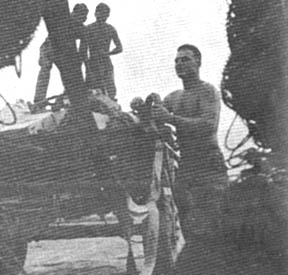 |
Page 4-5 TROPIC LIGHTNING NEWS September 1, 1969
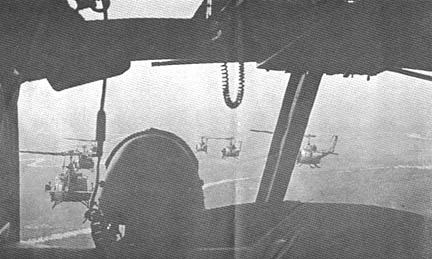 |
| VIEW FROM THE TOP - A heliborne assault by Alpha Company, 2/14th Infantry flies over the meandering Saigon River. The seven-ship lift carried the Golden Dragons from Fire Support Base Patton II on an operation near Trang Bang. |
The Golden Dragons: A Day in the Life . . .
|
Photos By PFC Frank Ditto |
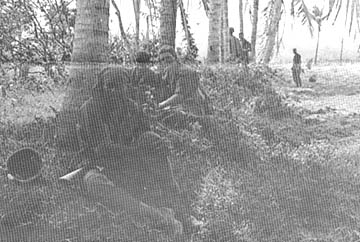 |
The Golden Dragons of Alpha Co. 2/14th Infantry are down but not out as they relax for a moment during an operation of securing a village. Palm trees provide the needed shade. |
| Casting a long shadow as he sloshes through a rice paddy is 2LT Richard Heier of Green Bay, Wis. Heier is on patrol with Charlie Company, 2/14th Infantry. | 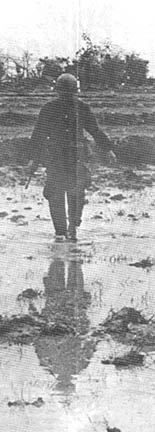 |
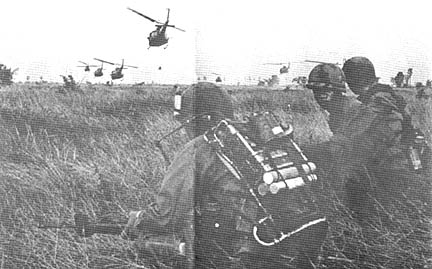 |
SECURE LZ - A quick security cheek by squad leader Specialist Edward Brown insures all his men are down safely. Assault helicopters lift off after inserting the Golden Dragons of Alpha Company, 2/14th Infantry. |
| Time out for a break permits Sergeant Doug Nesselrodt, Libourn, Mo, to make his own shade under palm leaves. Nesslerodt is sweeping with the Golden Dragons of the 2/14th Infantry. |  |
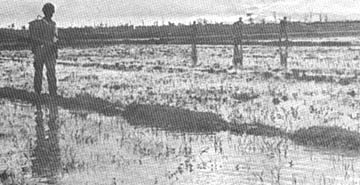 |
Tiptoeing on a paddy dike sure beats walking through sixteen inches of mud as the Golden Dragons from Charlie Company, 2d Bn., 14th Infantry try to keep dry on a sweep near Cu Chi. |
 |
| ABOVE
- Charlie Company, 2/14th Infantry walks a staggered sweep through a deserted
enemy bunker complex around Sa Nho, northwest of Cu Chi base camp.
BELOW - If there is rough terrain around, the infantrymen will find it. Here, men of the Golden Dragons, 2/14th Infantry, trudge through thick brush on an operation near Trang Bang. |
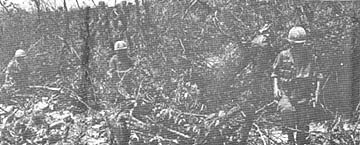 |
Page 6 TROPIC LIGHTNING NEWS September 1, 1969
Catcher
in the 'Nam
Fisk Eyes Baseball Career
By 1LT. J. T.
Richards
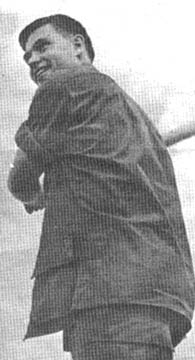 CU
CHI -
If you're a baseball fan bemoaning your absence from your favorite bleachers
this season, you can sympathize with First Lieutenant Calvin S. Fisk, 2d
Brigade's assistant S-1.
CU
CHI -
If you're a baseball fan bemoaning your absence from your favorite bleachers
this season, you can sympathize with First Lieutenant Calvin S. Fisk, 2d
Brigade's assistant S-1.
Fisk, if he weren't in the
Army and in Vietnam might well be playing in the major leagues with the
Baltimore Orioles.
"I've played baseball
for as long as I can remember," Fisk, a Charleston, N.H., native says.
"I started learning to catch the ball when I was three years old."
From then on, Fisk's
baseball career escalated through the sandlots, Little League, junior high and
high schools, Babe Ruth League, American Legion, and college ball at the
University of New Hampshire mixed with summers in a strong amateur circuit, the
Cape Cod League.
"Cape Cod baseball was
very important to me," Fisk recalls. "The
players were often older and more experienced, from all over the country and I
picked up a lot of valuable tips while playing in a league covered by a number
of major league scouts."
Fisk, a catcher, started a
successful career at New Hampshire by hitting .424 as a freshman, and by the end
of his junior year, the Orioles had offered him a contract.
"Playing pro baseball was
something I'd looked forward to all my life, but I wanted to finish my
schooling, so I decided not to sign," Fisk recalls.
The Orioles, however,
wouldn't give up that easily. After
Fisk graduated in 1966, the Orioles again asked him to sign.
When spring training rolled around in 1967, Fisk was at Baltimore's
Florida camp.
Fisk impressed Oriole
officials enough to get a shot at the team's Class A Florida State League farm
club, the Miami Marlins. He made
the most of the opportunity, hitting .296 and swatting five home runs in his
first year of pro ball.
Right now Fisk is more
concerned with meeting suspense dates than baseballs, and is catching more
clerical errors than would-be base stealers.
"I've kept in good shape
since I entered the Army," Fisk says. "My
arm is strong, and I'm still throwing well; only my hitting may be a little
rusty."
STAYING
READY
- (Above, right) First Lieutenant Calvin S. Fisk, 2d Brigade assistant S-1 and a former
catcher in the Baltimore Oriole farm system, gets in a few practice swings with
a weighted bat he brought to Vietnam.
(PHOTO BY 1LT J. T. RICHARDS)
Regulars
Invade NVA Camp
TAY
NINH
- The only sound that could be heard was the slashing of the machete as the
point man hacked his way through the thick jungle southwest of Fire Support Base
St. Barbara (French Fort).
Suddenly the quiet was
broken by the staccato of enemy machineguns on either side of the pointman and
platoon leader. Miraculously
neither was hit as each scrambled for cover.
First Lieutenant Frances L.
Mayo of McKenzie, Tenn., 3d Platoon leader for Alpha Company, 3d Battalion, 22d
Infantry Regulars, realized that, having lost the element of surprise, the enemy
was in a precarious position.
Using fire and maneuver, the
"Alphagators" advanced and the enemy machinegunners realizing their
positions were now indefensive, fled dragging a dead compatriot.
Pursuing the enemy, the Regulars came into a tightly knit system of 25
bunkers surrounded by a trench.
Moving cautiously through
the maze of bunkers, the Regulars threw grenades in each position, and this
approach yielded one more NVA killed. After
the initial pass through the system the infantrymen doubled back to see what the
fleeing enemy had left behind. Miscellaneous
web gear, cooking utensils, and medicine were discovered.
Although no weapons were
found, it was soon discovered what the NVA wanted to save so badly.
Over 1,000 pounds of polished rice were found, and numerous sleeping huts
built on top of the bunkers were destroyed.
Wolfhounds
Battle Insurgent Mud
CU
CHI -
Wolfhounds of the 1st Battalion, 27th Infantry, are all bogged down in their
fight against one of the most tenacious enemies in South Vietnam.
Ever since mid-July, when
the Wolfhounds moved to Fire Support Base Chamberlain along with the 2d
Battalion, 77th Artillery, Mother Nature has been waging her own battle against
the occupation. Daily monsoons have
shown no mercy and solid ground is well hidden by about three feet of mud.
The Wolfhounds didn't give
up easily though. With the help of
Delta Company, 65th Engineer Battalion, most of the water and mud is now on the
outside of the perimeter wire.
Fire Support Base
Chamberlain is looking up now and things have pretty much returned to normal.
However, the Wolfhounds will remember the mud as one of the most gripping
enemies they ever have encountered.
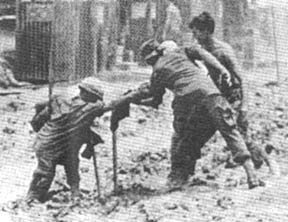 |
HELP! - This new replacement at the 1st Battalion, 27th Infantry Wolfhounds' Fire Support Base Chamberlin found the going tough even inside the wire. Luckily, some new friends were nearby to pull him to firm footing. (PHOTO BY SP5 JACK R. ANDERSON) |
Rooms
in Taipei Scarce This Month
Accommodations in Taipei
will be very scarce during mid-September and all of October, USARV headquarters
warns.
A large number of overseas
Chinese residents are expected to visit the city during celebrations of the
Republic of China National Day, the annual Presidential review, and President
Chiang Kai-Shek's birthday.
USARV suggests that anyone
planning to visit Taipei schedule his visit accordingly.
Page 7 TROPIC LIGHTNING NEWS September 1, 1969
House
Calls by Helicopter
Tomahawk Medics Fly to MEDCAP
TAY
NINH
- Infantrymen are accustomed to flying on eagle flights into landing zones
before starting operations in Vietnam. But
until recently medical civil action program (MEDCAP) personnel of the 4th
Battalion (Mechanized), 23d Infantry Tomahawks had never begun one of their
operations with an eagle flight.
The hamlet of Xa Tan Hung,
two miles north of the slopes of Nui Ba Den, had not been visited by the
Tomahawk MEDCAP team since the recent enemy flareups around the mountain began.
In order to bring needed medical care to the villagers, Major Alfred
Prieto, of Colombia, South America, the battalion surgeon, decided on an
"airmobile" MEDCAP.
With ground troops from the
4/23d's Bravo Company and reconnaissance platoon providing security, the
MEDCAP began.
"We were all a bit
skeptical," said Sergeant Dennis D. Myers of East Canton, Ohio, a medic.
"But our doubts were soon eased."
During three hours of
treating villagers, medics treated everyone from month-old babies to village
oldtimers. "We must have treated
over 200 people," commented Specialist 5 Robert W. Bagshaw of Red Bluff,
Calif.
Lieutenant Colonel G.E.
Taylor of Shelby, N.C. observed the airmobile MEDCAP and commented,
"Operations such as this are a big step toward putting the Republic of Vietnam
on its own two feet."
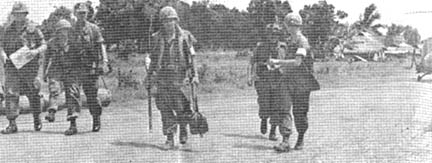 |
| THE AIRMOBILE MEDCAP team of the 4th Battalion (Mechanized), 23d Infantry, arrives at Xa Tan Hung, two miles north of Nui Ba Den, to treat hamlet occupants. More than 200 people turned out for the Tomahawk medics' session. |
| REPAIR JOB - Specialist 5 Robert W. Bagshaw of Red Bluff, Calif., bandages an ARVN soldier's knee during the MEDCAP. Tomahawk medics treated a wide range of problems during their eagle flight operation. | 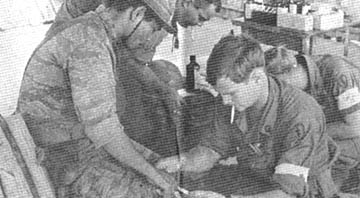 |
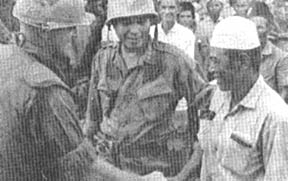 |
HELLO - Lieutenant Colonel G.E. Taylor of Shelby, N.C., Tomahawk commander, greets the hamlet chief of Xa Tan Hung as Dai Uy Loc, assistant district chief of Phuoc Ninh District, looks on. Taylor led the Tomahawks' MEDCAP team into the hamlet on a heliborne house call. |
| ANTICIPATION - A group of children wait, apparently with mixed emotions, for the MEDCAP team to get around to them. After a goodie distribution by the Tomahawks, however, everybody was smiling. | 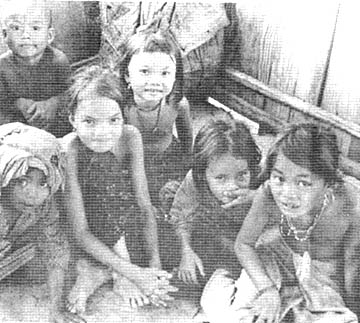 |
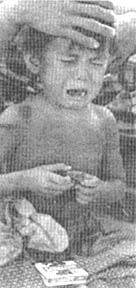 |
WORRIED - Even a plentiful supply of candy couldn't take this little girl's mind off the uncertainty of a medical examination by the 4th Battalion (Mechanized), 23d Infantry's surgeon, Major Alfred Prieto, of Columbia, South America. Prieto and battalion medics treated everyone from month-old babies to village oldtimers in Xa Tan Hung, two miles north of Nui Ba Den. |
Page 8 TROPIC LIGHTNING NEWS September 1, 1969
Enemy
Reaching New Heights
By PFC Frank Ditto
CU
CHI -
On a sweep in the northern section of the Ho Bo Woods seven miles northwest of
Cu Chi, Delta Company, 2d Battalion, 14th Infantry, came upon an unusual NVA
base camp - and destroyed it.
Located on high ground in a
rectangular bamboo hedgerow was a bunker-tunnel complex.
The bamboo was so thick and tall that the overhanging limbs formed a
ceiling for the camp.
IN
ONE CORNER
of the enemy complex was a 111-foot lookout tower, an extraordinary facility for
an NVA area. The tower was built on
a single pole with steps leading to a platform which was intended for an
observation stand. The bamboo
offered excellent camouflage for the tower and overhead limbs protected the
sentry.
As the 2/14th Golden Dragons
moved up to the hedgerow, the point man spotted a small break in the bamboo.
He waited for the rest of the company to set up security around the
complex and then moved into the hole to check the dense hedgerow on the inside.
AS
HE BEGAN
to find bunkers and tunnels, he called for help, and another member of his squad
came in to offer aid. The two men
found freshly cooked rice and NVA clothing stored in the bunkers.
As they moved toward one corner of the hedgerow, a trap door suddenly
popped open and a grenade came flying out.
Both men quickly took cover and started to move back out through the
thick bamboo.
AFTER
THEY
were clear of the hedgerow, the NVA soldiers started coming out of spider holes
and tunnels trying to escape. As
they moved out of the hedgerow through thick elephant grass, the Tropic
Lightning soldiers opened fire and eliminated many of the enemy soldiers.
A sweep of the area also led
to discovery of a shower point that contained soap, hand grenades, and mortar
rounds, plus the weapons carried by the NVA soldiers.
"I believe what we found
was a staging and rest area," explained Captain Thomas L. Waldera of Algona,
Iowa. "The lookout tower allowed
the NVA to see several miles in all directions.
The men did an excellent job of routing and destroying the enemy from his
well-hidden base camp."
Regulars
Have Long Day; VC Have Last
By SP4 K.C. Cullen
TAY
NINH
- Combat assault was the order of the day.
As soon as Charlie Company,
3d Battalion, 22d Infantry Regulars jumped off ships from the 187th Assault
Helicopter Company, the men knew it was going to be a long day of combat.
They knew it because as the ships lifted off, 61mm mortars began to hit
the area of the landing zone.
SUPPORTING
ARTILLERY
was called in as Captain Norman F. Sligar of Boise, Idaho, company commander,
gathered his two platoons and dropped back to a clump of woods to link up with a
company of the 2d ARVN Airborne Battalion.
After coordinating with the
ARVN commander and his American liaison officer, the combined force moved south
into a heavy hedgerow. They
didn't get far before both elements began receiving heavy small arms fire
after the point man from the American unit cut a piece of communication wire
which was running parallel to his front.
The massive enemy automatic
weapons fire made maneuver impossible and the allied units fell back while the
forward observers of both elements summoned artillery to pound the enemy
positions.
FOLLOWING
THE
ARVN-American barrage, Lieutenant Colonel Jefferson K. Rogers of Aurora, Colo.,
3/22d battalion commander, had the big guns shut down to let gunships hit the
area with miniguns and rockets.
Heavy .51 caliber fire was
encountered but F-105 fighter-bombers deposited their bomb loads on target and
the anti-aircraft fire soon ceased.
Then the ground troops moved
back into the area. The deeply
entrenched VC-NVA force was still strong enough to put out heavy automatic and
small arms fire. Again the allies
were forced to fall back 200 meters, set up a defensive posture and watch as
Rogers let the artillery, gunships, and jets rip into the enemy positions.
With dusk approaching, the
combined units set up night defensive positions and reinforcements were lifted
into the area with supplies.
MOVEMENT
WAS
spotted throughout the night, but no enemy attacks materialized.
Next morning, the allied force moved back into the contested area.
No resistance was met as
they cautiously prowled through the dense growth.
The enemy had fled but behind him he left 23 bodies, some buried in
shallow graves and caved-in bunkers.
One AR-50 rifle and several
hundred rounds of .51 caliber ammunition were found nearby. The troops also confiscated an assortment of web gear,
cooking and digging equipment in and around the well-constructed bunkers.
| WHAT MANNER OF GRUNT? - Mechanized infantrymen of Alpha Company, 4th Battalion (Mechanized), 23d Infantry, watch with curiosity as members of Alpha Company, 4th Battalion, 9th Infantry Manchus scramble after jumping off an eagle flight. The Tropic Lightning units were working together on an operation near Tay Ninh City. (PHOTO BY SGT ROGER WELT) | 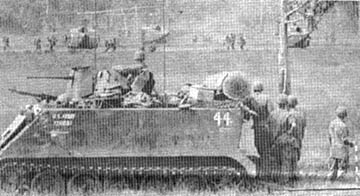 |
Watering
the Top of Old Nui
TAY
NINH
- Continuing its drive to bring all the comforts of home to GIs encamped atop
Nui Ba Den, Alpha Company, 65th Engineers, has completed a 40,000 gallon
reservoir there to provide a dependable water source.
Alpha Company, which had
previously built helipads and defensive fortifications and cleared land on the
peak, worked for two-and-a-half months to complete the reservoir after the 588th
Engineer Battalion laid the groundwork.
The company's third
platoon faced some unique problems in taking some of the desert duty aspects out
of working on the mountain top. The
"First In, Last Out" soldiers overcame the necessity to build the reservoir
on a slope, the absence of a mixing machine that forced them to mix nearly 900
bags of cement by hand, using empty ammunition boxes and hoes, and a shortage of
rock to make the concrete.
The reservoir, along with a
water purification unit, provide the mountaintop troops with an independent
water supply, for drinking and mess hall use, as well as for a welcome addition
to the outpost's facilities - a shower room.
|
|||
| HIGH-RISE WATER HOLE - Rising to new heights, Alpha Company of the 65th Engineers moved to the top of Nui Ba Den to build a 24,000-gallon reservoir (above left) for troops stationed there. It took engineers two-and-a-half months to complete the project. When it was done, project supervisor First Lieutenant Bruce Roberts of Gohanna, Ohio, got a free ride to a bath from his men to christen the structure (above right). |
Warriors
Put No-Rice Diet In VC Future
CU
CHI -
The 2d Battalion, 12th Infantry Warriors recently put a sizable dent in the
enemy's food supply.
During an airmobile
operation in the Boi Loi Woods about 10 miles northwest of Cu Chi, the Warriors
captured 24 100-pound bags of polished rice as well as five 100-pound bags
containing medical supplies. The
operation began when elements of Charlie Company were airlifted to two separate
locations in the same general area. These
two elements moved through their designated areas and linked up without
incident. Shortly after the
link-up, the point platoon discovered the large rice cache.
First platoon weapons squad
leader, Sergeant Harold Fullum of Thomasville, N.C., first spotted the rice
supply. Fullum said: "We were
moving toward the pick-up zone when I noticed an unusual looking bush.
Together with a Kit Carson scout ( a former Viet Cong who rallied to the
government) I moved over to check it out. We
found a carefully concealed bunker. The
bags of rice and the medical supplies were stacked on boards and logs next to
the fighting position. The entire
cache had been covered with large sheets of plastic."
Thanks to
Mack D. Gooding, 15th PID, 1st Bde., for sharing this issue,
Kirk Ramsey, 2nd Bn., 14th Inf. for creating this page.
This page last modified 8-12-2004
©2004 25th Infantry Division Association. All rights reserved.